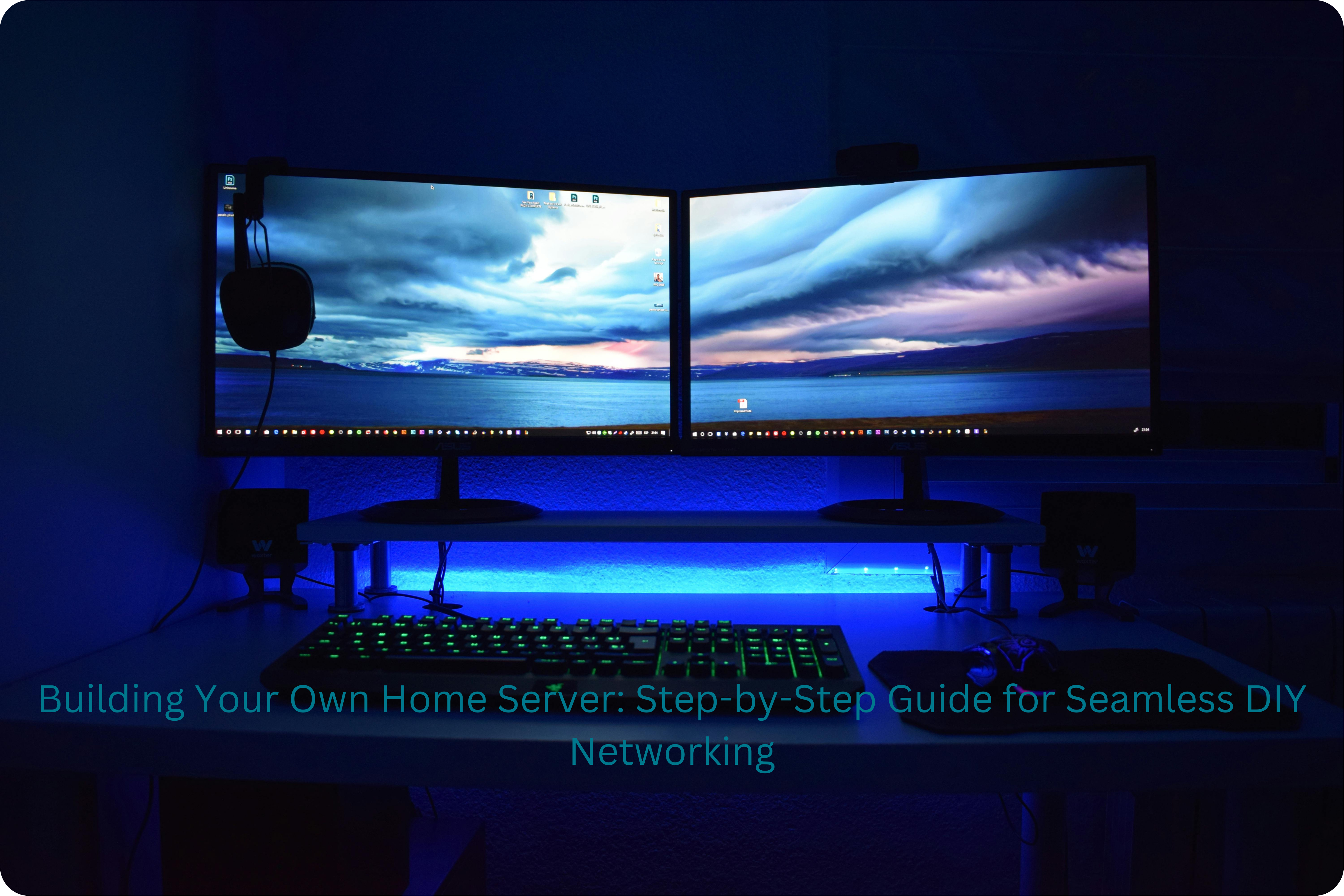Welcome to our informative blog post on creating your own DIY home server! In this comprehensive guide, we will walk you through the step-by-step process of building a seamless home server for all your networking needs. Whether you’re a tech enthusiast or simply looking to optimize your home network, this article will provide you with valuable insights and practical tips. So, let’s dive in and explore the world of DIY home servers!
Choosing the Right Hardware for Your DIY Home Server
When it comes to building your own home server, selecting the right hardware is crucial for optimal performance and reliability. Here are some key factors to consider:
1. Processor (CPU)
The processor is the brain of your home server, responsible for handling all the computations. Look for a CPU with multiple cores and a high clock speed to ensure smooth multitasking and fast data processing.
2. Memory (RAM)
Having enough memory is essential for running multiple applications simultaneously. Aim for at least 8GB of RAM, but if you plan on hosting resource-intensive applications or virtual machines, consider 16GB or more.
3. Storage Drives
Choose between traditional hard disk drives (HDDs) and solid-state drives (SSDs) based on your needs. While HDDs provide more storage capacity at a lower cost, SSDs offer faster read/write speeds, enhancing overall server performance.
4. Motherboard
Your choice of motherboard should support the CPU and RAM you’ve selected, and offer sufficient expansion slots for future upgrades. Additionally, ensure it has enough SATA ports to accommodate your storage drives.
5. Network Interface Card (NIC)
Investing in a reliable NIC is crucial for seamless network connectivity and fast data transfer speeds. Look for a Gigabit Ethernet card to ensure high-performance networking.
6. Power Supply Unit (PSU)
Opt for a power supply unit that can provide enough wattage to support all your hardware components. Consider a modular PSU for easier cable management and improved airflow within your server case.
By carefully selecting the right hardware components, you’ll lay a solid foundation for your DIY home server. In the next section, we’ll discuss the importance of choosing the appropriate operating system.
Selecting the Perfect Operating System for Your DIY Home Server
The operating system (OS) you choose for your DIY home server plays a crucial role in managing resources, security, and compatibility. Here are some popular options to consider:
1. Ubuntu Server
Ubuntu Server is a popular choice for beginners due to its user-friendly interface and extensive community support. It offers a stable and secure environment for hosting various applications and services.
2. CentOS
CentOS is a free and open-source Linux distribution known for its stability and long-term support. It is widely used in enterprise environments and offers robust security features.
3. Windows Server
If you’re more comfortable with the Windows environment, Windows Server is a suitable choice. It provides a familiar interface, excellent compatibility with Microsoft applications, and robust management tools.
4. FreeBSD
FreeBSD is a reliable and secure operating system known for its stability and performance. It is particularly popular for hosting websites and offers advanced networking capabilities.
5. OpenMediaVault
If your primary focus is creating a media server, OpenMediaVault is an excellent option. It is a user-friendly NAS (Network-Attached Storage) solution that supports various media streaming protocols.
6. UnRAID
UnRAID is a flexible operating system that specializes in managing storage devices, making it ideal for building a powerful and efficient file server or NAS. It offers data protection and easy drive expansion.
Consider your specific needs, technical expertise, and compatibility requirements when selecting an operating system for your DIY home server. The next section will guide you through the installation process.
Installation and Configuration of Your DIY Home Server
Once you have chosen the hardware and operating system for your DIY home server, it’s time to dive into the installation and configuration process. Follow these steps to get your server up and running:
1. Prepare Installation Media
Create a bootable USB drive or DVD containing the installation files for your chosen operating system. Check the official documentation or online resources for detailed instructions.
2. BIOS/UEFI Settings
Access your server’s BIOS/UEFI settings by pressing the designated key during startup. Ensure that the boot order is set to prioritize the installation media, allowing your server to boot from the USB drive or DVD.
3. Install the Operating System
Follow the on-screen instructions to install the operating system onto your server’s storage drive. Choose the desired language, partition scheme, and installation options as per your preferences.
4. Network Configuration
After the installation, configure the network settings of your home server. Assign a static IP address or set up DHCP reservation to ensure consistent connectivity within your local network.
5. Security Measures
Implement essential security measures to protect your server from potential threats. This includes configuring a firewall, enabling automatic system updates, and creating strong user passwords.
6. Additional Software and Services
Install any additional software or services you require on your home server, such as web servers, file sharing protocols, media streaming applications, or virtualization platforms.
By following these installation and configuration steps, you’ll have a fully functional DIY home server ready to meet your specific needs. In the next section, we’ll explore tips for optimizing and maintaining your server’s performance.
Optimizing and Maintaining Your DIY Home Server
Now that your DIY home server is up and running, it’s important to optimize its performance and ensure smooth operation. Here are some tips for optimizing and maintaining your server:
1. Regular Updates
Stay on top of operating system updates, security patches, and software upgrades to keep your server running smoothly. Set up automatic updates or establish a regular update schedule to ensure you have the latest features and bug fixes.
2. Monitoring and Performance Tuning
Utilize monitoring tools to keep an eye on your server’s performance and resource usage. Adjust server settings, such as caching, virtual memory, and network configurations, to optimize performance and ensure efficient resource utilization.
3. Backup and Disaster Recovery
Implement a robust backup strategy to protect your data from unexpected failures or disasters. Regularly backup your important files and configurations and consider using off-site backup solutions or cloud storage for added protection.
4. Security Measures
Continuously monitor and enhance the security of your home server. Regularly update firewall rules, enable intrusion detection systems, and install security plugins or applications to protect against potential threats.
5. Energy Efficiency
Configure power management settings to optimize energy consumption and reduce your server’s environmental impact. Enable sleep or hibernation modes during periods of inactivity and consider using energy-efficient hardware components.
6. Documentation and Organization
Maintain proper documentation of your server’s configurations, installed software, and network settings. This will help you troubleshoot issues more efficiently and ensure a smoother transition when upgrading or migrating your server.
By following these optimization and maintenance practices, you can ensure the longevity and optimal performance of your DIY home server. In the next section, we’ll explore some advanced tips and tricks for expanding the capabilities of your server.
Expanding the Capabilities of Your DIY Home Server
Your DIY home server has the potential to do much more than just basic file storage and sharing. With some advanced tips and tricks, you can expand its capabilities and unlock new possibilities. Here are some ideas to consider:
1. Virtualization
Explore the world of virtualization by running virtual machines (VMs) on your home server. This allows you to create isolated environments for different applications or even run multiple operating systems simultaneously.
2. Media Streaming
Transform your home server into a media powerhouse by setting up media streaming services. Install software like Plex or Emby to organize and stream your media collection to various devices within your home network.
3. Home Automation
Integrate your DIY home server with smart home automation systems for enhanced convenience and control. Use platforms like Home Assistant or OpenHAB to automate tasks, control devices, and create custom routines.
4. Web Hosting
If you have a desire to host your own websites or web applications, leverage your home server for web hosting. Install web server software like Apache or Nginx and configure virtual hosts to host multiple websites.
5. Game Server Hosting
If you’re a gaming enthusiast, consider setting up game servers on your home server. With the right software and configurations, you can host multiplayer game servers for you and your friends to enjoy.
6. Remote Access and VPN
Enable remote access to your home server by setting up a secure VPN (Virtual Private Network) connection. This allows you to access your server’s resources securely from anywhere in the world.
By exploring these advanced possibilities, you can take your DIY home server to the next level and create a versatile and powerful system that meets your unique needs. In the final section, we’ll conclude our guide and summarize the key takeaways.
In conclusion, building your own DIY home server opens up a world of possibilities for optimizing your home network and expanding its capabilities. By carefully selecting the right hardware components, choosing the appropriate operating system, and following the installation and configuration process, you can have a fully functional server tailored to your specific needs.
Optimizing and maintaining your server’s performance through regular updates, monitoring, backup strategies, and security measures is crucial for its smooth operation. Additionally, exploring advanced options like virtualization, media streaming, home automation, web hosting, game server hosting, and remote access can further enhance the capabilities of your DIY home server.
Remember to document your server’s configurations and keep everything organized for easier troubleshooting and future upgrades. With the right approach and ongoing maintenance, your DIY home server will continue to serve you efficiently and effectively.
We hope this comprehensive guide has provided you with valuable insights and practical tips for building and optimizing your DIY home server. Enjoy the benefits of a personalized and powerful home network setup!

